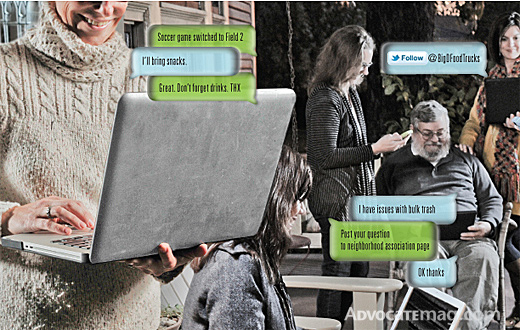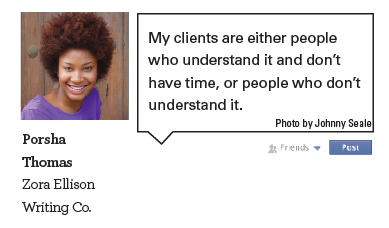The rise of social networking and virtual connections is changing things around here

Facebook is no longer just a silly tool for tracking down old flames or notifying the world that you are enjoying a fine sandwich. Along with other forms of digital interaction, organizations use Facebook to mobilize meetings and movements, reunite lost pets with owners, alert residents to prowlers and track down wanted criminals, to name a few. Social media can forge relationships, improve efficiency, boost business and promote safety within communities.
Of course, like any technology, it comes with a few pitfalls, and not everyone is on board.
• What’s a friend and a follow? Click here for a glossary of basic social media terminology you’ll see in this story.
• Read about how we’re using social media at the Advocate.
• Get ideas about how social media can benefit your neighborhood organization, business or group.
iNeighborhood
Little Forest Hills Neighborhood Association
 Remember the dark ages? Back in the olden days, maybe a decade or two ago, when PTA members dialed phone trees to blast messages about field trips, dress codes and communicable illnesses. Neighborhood association presidents hand-delivered newsletters from door to door. And when a pet lost its way, owners plastered the neighborhood with “lost” fliers. Some of
Remember the dark ages? Back in the olden days, maybe a decade or two ago, when PTA members dialed phone trees to blast messages about field trips, dress codes and communicable illnesses. Neighborhood association presidents hand-delivered newsletters from door to door. And when a pet lost its way, owners plastered the neighborhood with “lost” fliers. Some of
those communication methods linger on, but now, in the digital age, social media has become an easy and effective way for neighbors to communicate.
Social media, of course, is nothing new. We’ve been using Facebook and other social media to find long-lost classmates and connect with new crushes or business contacts for what seems like ages now, although it was more like 2008 for most users.
In the past year or so, however, Facebook has become the new front porch, a portal for community. Neighborhood associations, local businesses, police and schools use social media to stay in touch, spread news and stay organized.
“The only way we have of hitting every home in the neighborhood is our quarterly newsletter, which is hand-delivered to the homes,”
says Little Forest Hills Neighborhood Association president Max Davis. “It comes out a week or two before our general meeting.”
That newsletter contains helpful information for about 200 homes in the neighborhood. To the other 350 or so neighborhood homes, the contents probably are old news. The neighborhood association regularly sends news by email to those homes.
Last May, Little Forest Hills neighbors started using Facebook to stay in touch. Neighbors post information about lost pets, property crimes, suspicious activity and more through the online social network. While the association has been communicating by email for many years, Facebook makes it more personal.
“With Facebook, you can share photos from neighborhood events and links that might be relevant,” Davis says.
Neighbors “see” each other on Facebook, and when they see each other in real life, it is easier to make a connection, he says.
 The Lakewood Neighborhood Association has an online newsletter that is sent every month or so to some 900 subscribers. But the association’s website is updated several times a week with neighborhood news ranging from upcoming events to crime watch alerts. That’s useful information, but it could be a lot of work for nothing if not for social media, which drives readers to the website. The association’s webmaster, Lin Gold, promotes the neighborhood website through Twitter and Facebook.
The Lakewood Neighborhood Association has an online newsletter that is sent every month or so to some 900 subscribers. But the association’s website is updated several times a week with neighborhood news ranging from upcoming events to crime watch alerts. That’s useful information, but it could be a lot of work for nothing if not for social media, which drives readers to the website. The association’s webmaster, Lin Gold, promotes the neighborhood website through Twitter and Facebook.
“It’s all one communications package,” Gold says. “It’s really changed the way we communicate.”
Neighborhood residents also post information to the association’s social media pages that don’t necessarily make it to the website: Lost and found pets, thieves stealing landscaping plants, how to avoid marathon traffic, invitations to Sunday worship. It’s not always critical information, but as a whole, it is the fabric of community.
[youtube]http://www.youtube.com/watch?v=6UvHgynRchk[/youtube]
iCrime Fighting

Dallas Police YouTube channel • youtube.com/ DallasPoliceDept • Dallas Police post surveillance videos of crimes on the DPD YouTube channel. The popular video-sharing site allows police to seek the public’s help in identifying suspects as well as locating missing people and solving various types of cases.

iWatch App • dallaspolice.net • The iWatch app provides three options: Send in a text only, send in a text with a picture, or send an anonymous tip. You can also text a tip by typing DPD plus your tip to 274637, or you can call 214.671.4TIP.
The Lakewood Neighborhood Association often links to Nixle, the online service that alerts the public to police, traffic and emergency information. Users can receive alerts on their phones or by email, and within a few minutes, the Dallas Police can alert thousands of people through Nixle and iWatch Dallas, a similar service offered as a smart phone app.
Police recently put out an alert about a man impersonating a police officer in the White Rock Lake area. By the time the perpetrator’s face made the evening news, iWatch users already were on the lookout.
The Dallas Police Department also has arrived on the Facebook scene, posting regularly about wanted criminals, safety tips and crime trends, as well as department news. As far as solving crime goes, iWatch Dallas has been more effective than Facebook because it allows neighbors to send tips to police, says Deputy Chief C.L. Williams. Facebook is so public and personal that people rarely use it to send in crime tips, but it is an effective way for people in the community to feel connected to police, he says. To “like” the Dallas Police Department on Facebook makes the department seem more accessible.
 iSchool
iSchool
Neighbors also use social media to stay connected to their children’s schools.
J.L. Long Middle School PTA president Stacey Stabenow says she never was interested in Facebook, and she stayed away from social media until recently.
“Ms. Petters, the principal, asked me if I had Facebook,” Stabenow says. “She told me, ‘You might want to think about getting that.’ ”
Now Stabenow uses Facebook frequently, if reluctantly, to communicate with other Long parents. Several years ago, students were sent home with regular communiqués from teachers and principals, but that is less common now, Stabenow says.
“Finding out what’s going on at the school is challenging,” she says. “We keep the website updated, but Facebook is a great way to get the information out.”
Parents can access the page to find how they can help with staff appreciation day, get details on an upcoming Woodrow Wilson High School open house and learn the score of the boys’ basketball game.
Stabenow also uses social media to show off the school’s accomplishments — the math and science team racked up awards at a recent competition, for example. Those aren’t things your child is likely to tell you, Stabenow says.
Long isn’t the only school using social media. Most elementary schools in our neighborhood, including Lakewood and Stonewall Jackson, as well as the Lakewood Early Childhood PTA, use Facebook to keep in touch.
Social media also has become an essential marketing tool for many local businesses.
iBusiness
 Social media also has become an essential marketing tool for many local businesses.
Social media also has become an essential marketing tool for many local businesses.
Porsha Thomas provides social media content for several neighborhood businesses, including the Gypsy Wagon, through her business, Zora Ellison Writing Co. Thomas holds a journalism degree, but when she graduated a few years ago, she couldn’t find a job in the news business. The 25-year-old instead found her niche as a social media marketer through an internship with an online newsletter that offers tips on shopping and events.
About 80 percent of Thomas’s work involves social media.
“There are people who know they need Facebook, but they don’t understand it,” she says. “My clients are either people who understand it and don’t have time, or people who don’t understand it.”
She often designs event posters that never get printed. They’re used only on Facebook. Posting pictures and interacting with customers in social media is a valuable service, Thomas says.
“Photography really helps,” Thomas says of making effective Facebook posts for her clients. “People want to see what you have. Show, show, show. Put yourself on the page and portray that personality.”
Many businesses in our neighborhood maintain a steady presence on social media.Velvet Taco’s Twitter followers, for example, are the first to know what fusion concoction the trendy taquería is offering as a special. White Rock YMCA can show off the good work they do for the community, post pictures of a recent camping trip and alert the community to an upcoming blood drive. Neighbors can use Foursquare to check in 10 times at Mextopia and receive a free margarita.
When Terilli’s on Lower Greenville closed after a fire destroyed the restaurant, the owners and employees stayed in contact with their customers through Facebook. When the place reopened, there was no love lost. Regulars felt they were part of the rebuilding process, as they had watched it unfold through Facebook pictures.
Shortly after the restaurant reopened, one customer posted on Terilli’s Facebook page: “So happy to have you back in the neighborhood.”
iDallas
Four city hall web functions you probably haven’t used (but should)
 1. Check out library books to your mobile device.
1. Check out library books to your mobile device.
dallaslibrary.lib.overdrive.com
Not only does the Dallas Public Library have a thorough and useful app (with the swipe of a finger, search the catalog, place items on hold or renew items checked out) but it also has an extensive selection of eBooks available to borrow. Options range from New York Times bestsellers (John Grisham’s “The Litigators”) to classics (Ayn Rand’s “Atlas Shrugged”) to popular nonfiction (Michael Pollen’s “The Omnivore’s Dilemma”). We tried it, and in less than 10 minutes, we were reading on our iPhone. A helpful guided tour takes library cardholders through the process.
2. Find out whether your favorite restaurants passed inspection.
Go to code compliance page on dallascityhall.com
They wouldn’t be open if they hadn’t, but the section located at this lengthy web address allows you to see whether the places you frequent are receiving high scores or barely making the grade. A quick search by name reveals how a restaurant fared on its most recent inspections.
3. Run into Mark Cuban, Ebby Halliday or the Cowboys cheerleaders.
These local celebs are a sampling of the famous names and faces the Dallas Park and Recreation Department recruited to promote its recent trail etiquette campaign. Other than watching the amusing video, website visitors can view an interactive map to find the exact layout of Dallas trails (both current and planned) in relation to streets, rec centers and other local landmarks.
4. Learn which park pavilion beat out Cowboys Stadium as the 2009 “Best of Show” award recipient from the American Institute of Architects Dallas chapter.
This little-known fact is touted in the online brochure “The Park Pavilions of Dallas,” which highlights 44 of the city’s shade-giving structures. Thirty-two of them were designed by respected architects who were charged with making the pavilions “contextual within the surrounding community and embraced by the neighborhood,” among other criteria. That’s how the structure at Lindsley Park, for example, resembles the predominantly Tudor homes of Hollywood/Santa Monica, and the reason Ridgewood Park has a chaise lounge pavilion near its spraypark.






